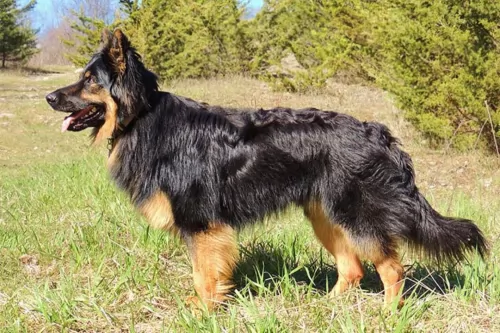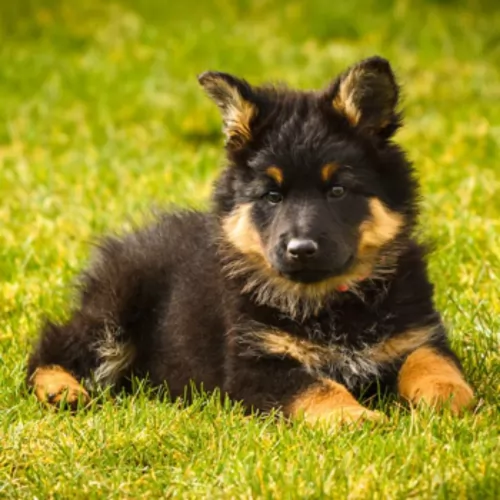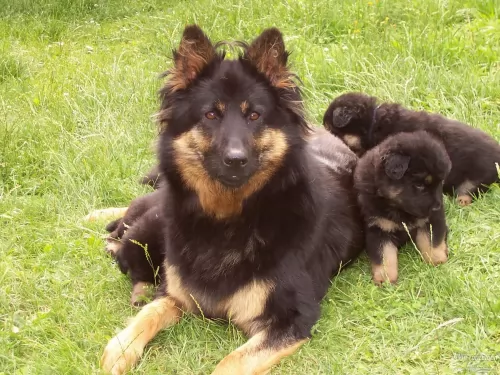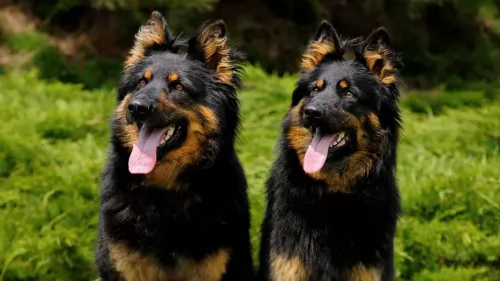 Petzlover
Petzlover Bohemian Shepherd is originated from Czech Republic but Rhodesian Ridgeback is originated from Zimbabwe. Bohemian Shepherd may grow 13 cm / 5 inches shorter than Rhodesian Ridgeback. Bohemian Shepherd may weigh 16 kg / 35 pounds lesser than Rhodesian Ridgeback. Both Bohemian Shepherd and Rhodesian Ridgeback has almost same life span. Bohemian Shepherd may have less litter size than Rhodesian Ridgeback. Bohemian Shepherd requires Moderate Maintenance. But Rhodesian Ridgeback requires Low Maintenance
Bohemian Shepherd is originated from Czech Republic but Rhodesian Ridgeback is originated from Zimbabwe. Bohemian Shepherd may grow 13 cm / 5 inches shorter than Rhodesian Ridgeback. Bohemian Shepherd may weigh 16 kg / 35 pounds lesser than Rhodesian Ridgeback. Both Bohemian Shepherd and Rhodesian Ridgeback has almost same life span. Bohemian Shepherd may have less litter size than Rhodesian Ridgeback. Bohemian Shepherd requires Moderate Maintenance. But Rhodesian Ridgeback requires Low Maintenance
 Known as the Chodský pes or the Chodenhund, the Bohemian Shepherd is native to the Czech Republic and is a herding breed. Like many other old dog breeds, nothing is 100% certain about is history. This is thought to be because the breed was developed centuries before the keeping of records. It is certain however, that the breed developed in the south-western portion of the Kingdom of Bohemia, which is now part of the Czech Republic.
Known as the Chodský pes or the Chodenhund, the Bohemian Shepherd is native to the Czech Republic and is a herding breed. Like many other old dog breeds, nothing is 100% certain about is history. This is thought to be because the breed was developed centuries before the keeping of records. It is certain however, that the breed developed in the south-western portion of the Kingdom of Bohemia, which is now part of the Czech Republic.
It is believed the Bohemian Shepherd came from herding dogs such as the Pinscher/Schnauzer, Spitzen or even a dog/wolf hybrid. It was in November 1991, that the Bohemian Shepherd Lover’s Club was founded. Many Bohemian Shepherd breeders have been registered and today the breed has earned the reputation for being a superb family dog. The dog has also been granted recognition with the Czech National Kennel Club.
 Known as the African Lion Dog, the courageous Rhodesian Ridgeback hails from Rhodesia, now Zimbabwe.
Known as the African Lion Dog, the courageous Rhodesian Ridgeback hails from Rhodesia, now Zimbabwe.
He was bred essentially to be a hunter as well as a home guardian. These dogs were crossed with European dogs, with the original breed standard being drafted by F.R. Barnes By the 1860s, European colonisers had imported certain European dog breeds to the area such as Greyhound, Terriers, Bloodhounds as well as other breeds. These were mixed with the indigenous African dogs.
The Ridgeback Club was also founded. It was in 1955 that the American Kennel Club recognized the dog as a member of the Hound group.
 The medium sized Bohemian Shepherd looks much like a combination between the Collie and German Shepherd. He is 48-55 cm in height and weighs about 15-25 kg. The Bohemian Shepherd has a thick, long coat which is black and tan in color and with an undercoat, allowing him to cope in icy weather conditions. His well proportioned body is muscular and compact with a long bushy tail and erect ears.
The medium sized Bohemian Shepherd looks much like a combination between the Collie and German Shepherd. He is 48-55 cm in height and weighs about 15-25 kg. The Bohemian Shepherd has a thick, long coat which is black and tan in color and with an undercoat, allowing him to cope in icy weather conditions. His well proportioned body is muscular and compact with a long bushy tail and erect ears.
The Bohemian Shepherd makes a wonderful family pet, becoming very attached to his human family. He has a good reputation with children too and will get on well with other pets in the home. He is so amicable that he makes a good pet choice for those looking to own a dog for the first time.
He is intelligent and alert and also protective of his family, making him an excellent guard dog. He is easily trainable, and just like with any other dogs, will require training and socialization.
 Perhaps the most noticeable thing with this large, handsome formidable looking dog is the ridge of hair that runs along his back and gives him his name. The rest of the coat is short and smooth and can be a reddish tan color or wheaten shade.
Perhaps the most noticeable thing with this large, handsome formidable looking dog is the ridge of hair that runs along his back and gives him his name. The rest of the coat is short and smooth and can be a reddish tan color or wheaten shade.
He is a slender, athletic dog with an alert, intelligent face. The ears of the dog are floppy and carried close to the head, being broad and then narrowing to a rounded ear. The tail is long,broad at the base and tapers. He is a large dog that stands at between 61 and 69cm and weighs between 29 and 41kg.
In spite of his athletic build, he isn’t an overly active dog like many other breeds but will require a walk ever day as well as ball- and rope games.
He is a quiet, gentle dog, strong and confident, while also being strong willed and independent. He is tolerant around children, but isn’t the kind of dog that relishes being around little kids who try to climb over him.
He is smart and can be easily trained. Training and socialization turn him into an awesome pet.
 Playful by nature, friendly, gentle and co-operative, your Bohemian Shepherd will make a wonderful pet and he is a real social character, loving to spend lots of time with his human family. With minimal health conditions and without requiring much maintenance, he is an adaptable dog and will easily settle into city- or country living, so long as he is given regular exercise and attention.
Playful by nature, friendly, gentle and co-operative, your Bohemian Shepherd will make a wonderful pet and he is a real social character, loving to spend lots of time with his human family. With minimal health conditions and without requiring much maintenance, he is an adaptable dog and will easily settle into city- or country living, so long as he is given regular exercise and attention.
He is courageous and intelligent and also makes an excellent guard-dog. With so much going for this beautiful dog, he simply makes a loyal, loving and devoted family pet.
 Your Ridgeback is a dignified dog who is devoted to his human family, being aloof around strangers.
Your Ridgeback is a dignified dog who is devoted to his human family, being aloof around strangers.
He is a territorial dog and takes his job as guard dog seriously. He is confident and independent, and with his good looks, his loyalty and devotion, he is guaranteed to make you a most splendid pet and companion.
 Breeding organizations are continually trying to minimize the diseases within limited-gene-pool dog breeds. While the Bohemian Shepherd is a generally health breed, there are diseases that are more common with the Bohemian Shepherd and which you need to be aware of -
Breeding organizations are continually trying to minimize the diseases within limited-gene-pool dog breeds. While the Bohemian Shepherd is a generally health breed, there are diseases that are more common with the Bohemian Shepherd and which you need to be aware of -
This is a painful disease – a problem with the formation of the hips – where the dog can develop arthritis and even become lame.
This is a condition where gas gets trapped in the stomach of your pet, so that he swells up, sometimes causing the stomach to twist. This is an emergency for your pet and it is extremely painful. Nobody really knows the cause, but when the gas is trapped inside the stomach, the bloated stomach of your pet requires you getting to the vet as quickly as you can.
Look out for Progressive Retinal Atrophy known as PRA . This is a group of degenerative diseases that affect the photoreceptor cells where the cells deteriorate and can result in blindness with your pet. Fortunately it isn’t a painful condition.
 Rhodesian Ridgebacks are generally healthy, robust dogs, but like with all breeds, they can also have their share of some of the common dog illnesses there are.
Rhodesian Ridgebacks are generally healthy, robust dogs, but like with all breeds, they can also have their share of some of the common dog illnesses there are.
If you’re buying a puppy, make sure it comes from a good breeder.
This is a hereditary disease which can become worse because of environmental factors such as rapid growth. The thighbone doesn’t fit properly into the hip joint.
It is sad when you see such a strong dog succumbing to hip dysplasia as it can cause a lot of pain and also make your dog lame. Arthritis can also occur.
For such a life threatening illness with a dog, it is wise to familiarize yourself with an emergency vet in your area. A dog with bloat needs to be rushed to the vet as soon as possible.
That is why it is better to feed your pet smaller meals daily rather than one big meal. Bloat is an ailment where there is rapid accumulation of gas in the stomach.
Dogs with deep chests are at a greater risk of bloat. Typical symptoms of bloat include restlessness, a swollen, hard stomach and trying to vomit.
Canine bloat or gastric dilatation and volvulus is a killer with dogs, with the gas accumulation causing the stomach to twist.
 The Bohemian Shepherd is an energetic breed and will need to be exercised regularly. He’ll love to run alongside your bike on your cycling trips or you can take him on a long walk. Having said that, he is an easy going dog and can adapt to city- and country life, but if it’s city life, you can’t leave him cooped up in a small yard and think that will suffice. He has a personality that longs to be part of the family.
The Bohemian Shepherd is an energetic breed and will need to be exercised regularly. He’ll love to run alongside your bike on your cycling trips or you can take him on a long walk. Having said that, he is an easy going dog and can adapt to city- and country life, but if it’s city life, you can’t leave him cooped up in a small yard and think that will suffice. He has a personality that longs to be part of the family.
Your Bohemian Shepherd is a moderate shedder in spite of his thick beautiful coat. The coat will certainly need a good brushing at least twice a week to get rid of that loose hair. Not only that, your social Bohemian Shepherd will love the closeness to you that the brushing brings.
Keep his nails short and his teeth brushed at least 2 or 3 times a week to ensure there is no plaque build up. There are special toothbrushes and toothpastes made for dogs. Don’t use human toothpaste as the ingredients will be harmful to your pet.
Your Bohemian Shepherd, after one year of age, will eat one or two bowls of food a day. You’ll be able to tell what suits your dog, because the amount will eat about 2 to 4 cups of a good quality dry dog food a day, split into at least two meals. The amount can vary depending on its health, build, age, activity level and metabolism. Make sure it has access to water at all times and that it is changed as often as possible.
 The Rhodesian Ridgeback only sheds a little so you can keep him looking good with a brush twice a week.The shiny coat can be maintained by wiping him down with a damp cloth. Look out for any unusual lumps you might find.
The Rhodesian Ridgeback only sheds a little so you can keep him looking good with a brush twice a week.The shiny coat can be maintained by wiping him down with a damp cloth. Look out for any unusual lumps you might find.
He has floppy ears so during your grooming session check inside his ears and make sure they aren’t red. You can suspect an ear infection when you see your Ridgeback shaking his head or scratching his ears.
Check inside your Ridgeback’s mouth too as dogs can’t tell you when they’ve got a rotten tooth that is causing terrible pain and also poisoning their entire system.
Trim his nails too if they don’t wear down naturally.
Your large Rhodesian Ridgeback will need good food from you if you want to have less visits to the vet because of illness.
If you have a puppy feed him 4 bowls of food a day, but once your dog is one year of age he can have two bowls of food. Two bowls are better than one as with one bowl, your dog becomes ravenous and gobble his food down. This can lead to bloat.
It is always convenient to feed him one of the top quality commercially manufactured dog foods but he will also need some tasty home-made food too. Boiled chicken, brown rice or pasta and spinach, sweet potatoes and carrots are a healthy choice for your pet – plain and simple dog food, just like dogs want.
They don’t want exotic, spicy foods that humans eat as it upsets their stomach. Chop this home-made food up ad put it into his dry kibble twice a week for a treat. Also try to give him a bit of raw meat occasionally. Never leave him without a constant source of fresh, cool water.